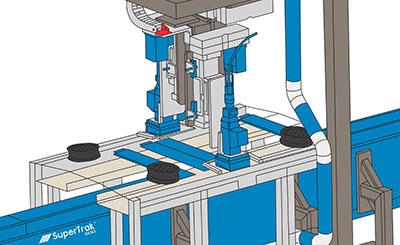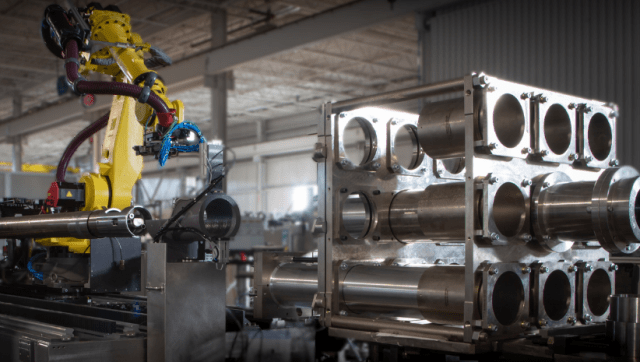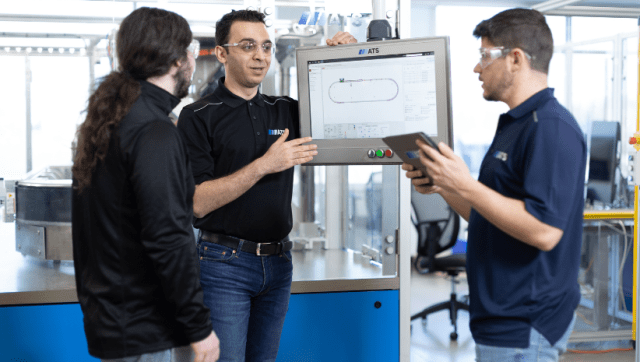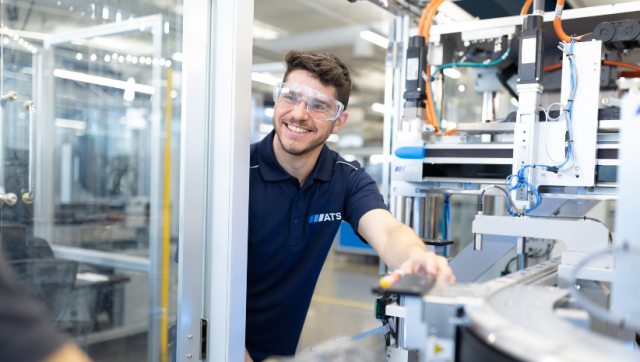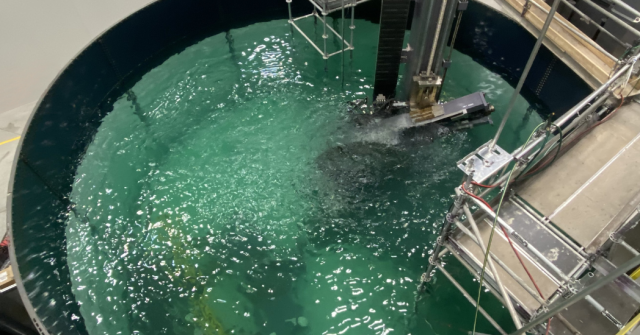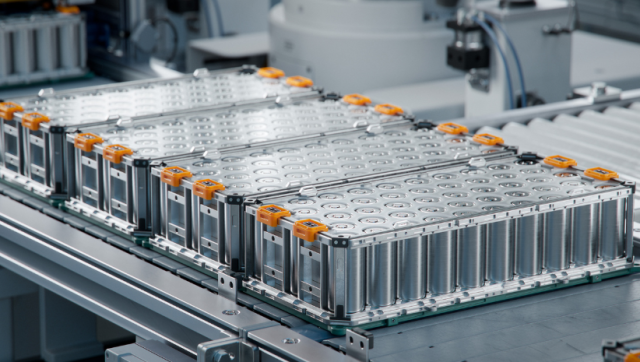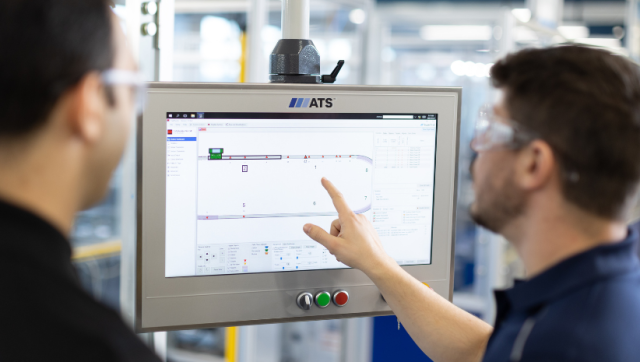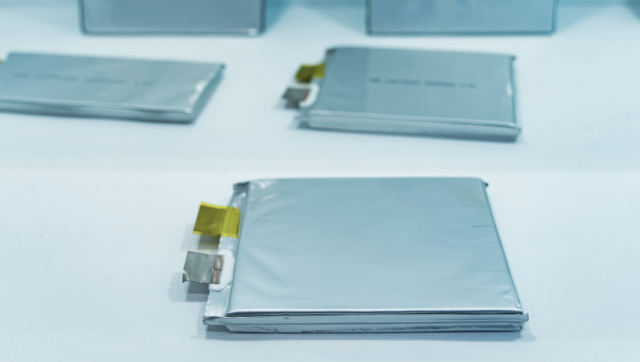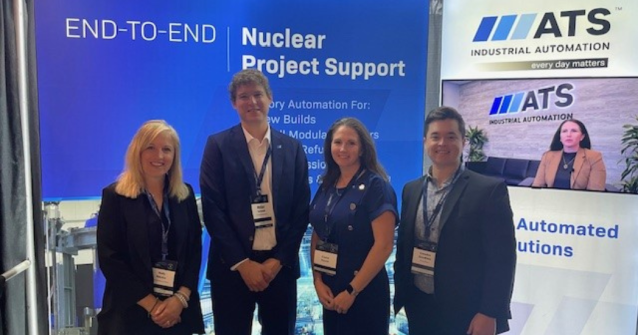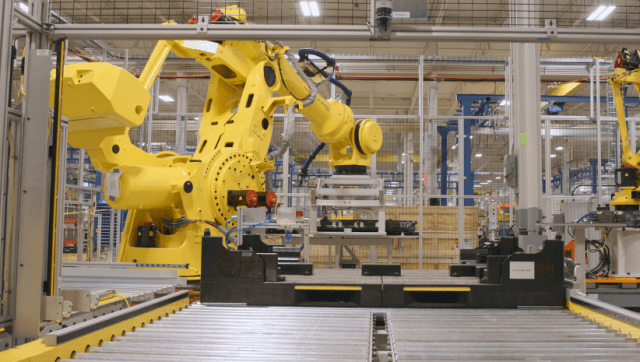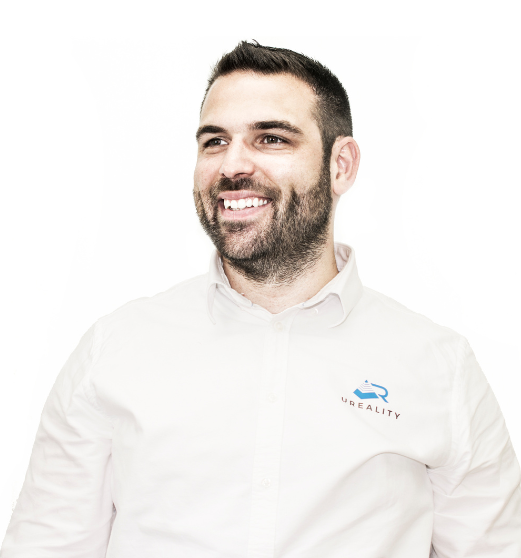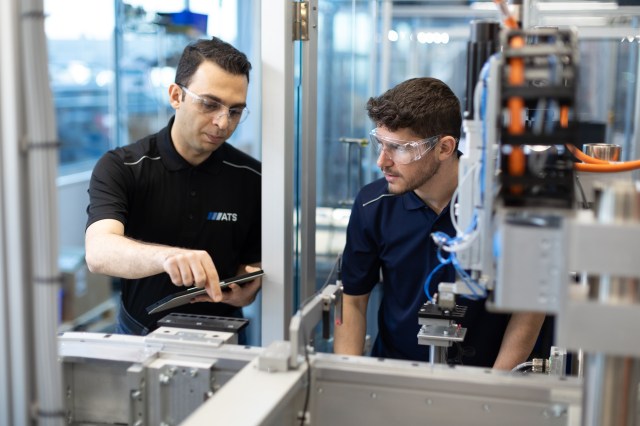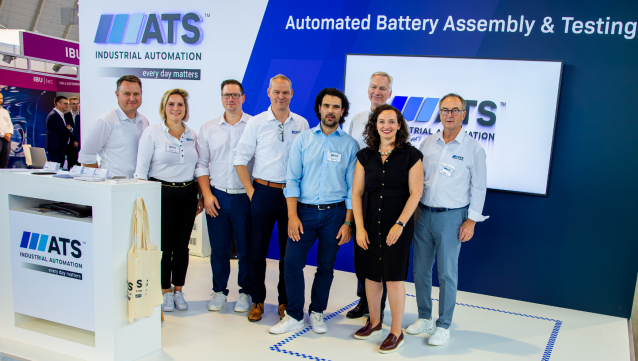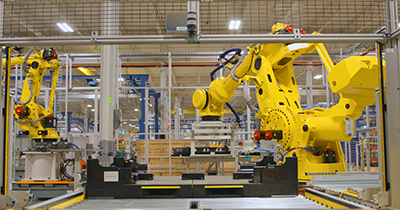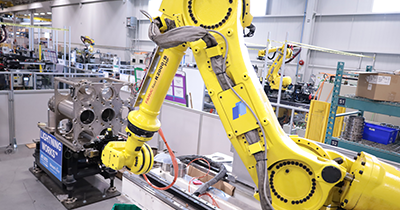20. May 2022
Die revolutionäre Entwicklung von Batterien zu bewältigen und gleichzeitig die Produktqualität zu gewährleisten, ist eine Herausforderung. Das Testen von Batterien ist keine simple Angelegenheit. Formfaktoren, Designelemente und Systeme ändern sich; sie sind nicht auf Dauer angelegt, und die Elektromobilität ist nur ein Anwendungsbereich für Batterien. Das Testen von Batterien erstreckt sich auch auf Strom, Netzspeicherung und mehr.
Erfahren Sie, warum ATS Industrial Automation auch weiterhin der bevorzugte Partner für die Herstellung von Batterien und deren Montage ist.
Wichtige Themen sind:
- Trends beim Testen von Batterien.
- Erkenntnisse aus den Testmethoden in der Elektromobilität.
- Wie sich die Erkenntnisse aus dem Bereich der Elektrofahrzeugbatterien auf andere Branchen übertragen lassen.
- Vor- und Nachteile einer internen bzw. externen Umsetzung.
Schauen Sie sich jetzt das Webinar „Das Testen von Batterien ist keine simple Angelegenheit“ an
HINWEIS: Das Video ist auf Englisch
Referenten
Gastgeberin
Mary Beth Vander Schaaf
Managing Editor, Automotive News.
Referent
Jack Porter
Applications Engineer Technical Specialist, ATS Industrial Automation.
Transkript
Mary Beth Vander Schaaf
Hello and welcome to Battery Testing Is Not as Simple as “Test a Battery”. This Automotive News webinar is brought to you by ATS Industrial Automation. We’re delighted you’re with us for this presentation. I’m Mary Beth Vander Schaaf, managing editor, at Automotive News. Our speaker is Jack Porter, Applications Engineer Technical Specialist, at ATS Industrial Automation. With 40 years of industrial tech experience, Jack has led and developed test processes and handling for leading automotive OEMs (Original Equipment Manufacturer). Jack assists customers in improving and automating their EV battery module and assembly test processes. Over the last decade he has concentrated on EV powertrain, power conversion, and power storage, helping OEMs increase throughput and improve EV test processes. I’ll turn it over to Jack to get us started.
Jack Porter
Welcome, I’m glad you all could join me today where we’re going to be talking about battery testing. The name of the presentation here is Battery Testing Is Not as Simple as “Test a Battery”. We’re going to spend some time on that, taking a look at what’s going on in the market today, and what’s going on within the engineering community within the production environment in terms of creating batteries as we define them today.
My name is Jack Porter, and I’ve been doing industrial tests for a long time as Mary Beth alluded to and very nicely spoke of me.
I appreciate that. I’ve been working mostly in power train, power conversion, and power storage for the last decade or so as we’ve been busily electrifying just about everything that’s out there. Over my many years of production testing, I’ve been through a few battles, got a few scars to show for it, and I’ve learned a few things. And today, some of the things we’re talking about the we learned has to do with battery testing.
What do you think about when you think about testing batteries? For example, if your headlamp’s not working do you pull out the cells and then get out your voltmeter and take a voltage measurement say, “Oh those batteries are dead” and put some new ones in. Or maybe if you’re a little more adventuresome, you go over to your smoke alarm detector that you have to replace the batteries in, and you plop a nine-volt cell and give it a little taste on your tongue and you feel the current tickle. And you go, “Oh, that’s a good battery”. This is testing a battery. But what we’re talking about today is going to be testing batteries with respect to the electric vehicle market and grid storage, and what we need to consider to be successful in production testing these batteries.
What is Energy Storage for the Future?
When I look around us today, I like to talk about the cliche that we’ve all heard, that the only constant is change. And sure, it’s a cliche, but it’s rooted in something. Today with respect to this market we’re talking about, it’s certainly true. There are exciting changes going on all around us that are evolving a lot of different directions.
Some of the things that we look at that are changing are the baseline chemistries in batteries, we look at the end applications — be it mobility, storage or range extensions. You look at what the batteries are themselves in terms of the packaging and the system connections. What are the charge and discharge requirements? How do we get things charged? What is it that we’re discharging them into? So, it’s just swirling all around us. My news feed is just filled with a stream of battery development projects, things that are going on all over the place in terms of producing batteries and installing them. We can look at large scale grid storage installations and the exciting chemistries.
Everybody’s trying to get the next big change in battery technology, and it goes across a variety of disciplines, and a variety of techniques. If you look as well in these quick searches, you’ll see that the investment in production is widespread. There are battery plants going up everywhere, all sorts of different types. And all the research and development in this field just continues to push the technological boundaries as we’re trying to reduce costs, reduce size, increase power density, it can be almost overwhelming. Combining this with the demands of production and all the changes —— How are we going to deal with this? What do we do? This is this is our challenge today.
The Magic Triangle
This demand is actual, but why is this a problem? Well, we’d like to think about it in terms of the magic triangle, and this magic triangle is trying to highlight and give us a framework to be able to break down all these converging factors that are going on that we’ve talked about. All those wonderful changes that are going on all impact us in terms of trying to do our jobs. It goes across everything.
Batteries Evolving Rapidly
If we look at this, we just kind of start from the left and to look to what’s over there and we talked about this a little bit already, the battery technology is improving at a rapid pace, and this has a big effect on production testing.
Long Lead Times of Automated Assembly and Test Lines
If we look at the time that it takes to do a battery project. Typical large scale assembly projects might take two to three years from the project start when there is a request for proposal, to the time that you get up to full scale production. And those kinds of timelines are just too long based on the demand. The demand is here today. What changes do we need to make in order to increase our ability to compress that timeline?
Many Change Orders
Additionally, we throw on top of that the changes — so now we’re moving up to another leg of the triangle. These changes make the project a moving target. How do we determine how it is we transition a manufacturing space to reach a full production in a shorter timeframe but, without the mature technologies and processes? We’re used to a slower pace where we go through this process and go through prototypes and pilot builds, and then further testing. Then we go to commercialization and start to scale up production and we don’t have time for that anymore. So, we have this convergence of these disciplines, perhaps that have not been assembled before.
We got new technologies, and all these different things that are going on and maybe we have groups within our organization, or we need groups from other organizations in order to bring this together and pull it off. Traditionally, we’ve leveraged historical gains and manufacturing efficiencies: we’ve taken what we learned in the past and brought it forward. We’ve had time in order to let that roll forward.
How do we gather the good that we got out of those historical gains and bring them into today? Now we start moving into the third side of this triangle, which gets into flexibility and how do we do things in order to be able to adapt to the pace of change in the high demand? And this is what we need to do within our organizations in order to ensure our success. To sum it up, despite not being a brand-new industry, batteries have been made for a long time but battery manufacturing is not a solved problem.
A Shift in Perspective
So, what I’d like to propose is that a shift in perspective is required. If we look at here, we see the things that I think we need to look at and change our perspectives on in terms of how we go about this in order to achieve our ET targets. What can we do to ensure our success? The challenges in battery manufacturing exist in several commercial and technical areas. We’re going to have to work in those areas if we’re going to do a shift.
Capacity
We look at what we have here in terms of capacity: domain knowledge, project management, and excellent scalability. These are the people we have today, they’re good people, we know them, and we know we do well. But the question is, can they do well for what we need going forward in our battery testing? Do we have the need for new approaches to our testing requirements? And so, I would say let’s start with what we have and focus on areas for learning, or modifying, or enhancing what we have. It’s kind of like how do we build ourselves up? How do we shift into this? And this is where the shifts come in.
Empower
We go to the passionate teams so we kind of start moving around in our perspective and this is how do we handle the timing factor. And this gets into the possibility and the capabilities we highly recommend in terms of working with somebody — somebody else to help you. This comes into collaborative, Original Equipment Manufacturers (OEM) like ATS. How do we develop our supplier relationships? And we all know what’s happening in supply chains today; how do we make that do something good for us? How do we become the person that is the key? What do we need to do to work back and forth? One of the things that’s historically been a stumbling block is the trusting portion of this in terms of getting dedicated people to help you to be embedded within your organizations. To act as an adjunct to you in order to be able to bring these things to fruition. The whole point is to be able to respond to the changes and to do it quicker.
Future Proof
And then as we look a little bit further downstream and we’re bringing the future proofing. What do we need to do today or consider today, in order to be able to handle the changes that’s occurring? Like I said, all these components are things we kind of know today but it’s a question of taking a deeper look, and re-aligning this in order to be successful in battery testing. We know we make the best-in-class components, and we know we use digital capabilities in terms of simulation and artificial intelligence and insights. What is it that we need to do today, in order to be successful as we go through this rapid change going on? Scalability and modularity are two big keys. And those are always difficult, especially modularity in terms of how do I do that? Where do I make those tradeoffs between upfront costs based on projected downstream modifications? How do I come up with something today, that is going to stand the test of time, and be able to handle the changes that are coming to us?
Simultaneous Not Parallel
One of the ways to do that we sum up by saying, “Simultaneous, not parallel.” And if we go to Webster’s, Webster’s is going to tell us simultaneously means occurring at the same time, exactly. Whereas parallel is everywhere, equidistant and not meeting. And I think a lot of times we tend to think about things being parallel processes. And that’s good. We have things that are going on at the same time. But the key thing here is we need to have these things meet, we must meet during the development, during the prototype, during the product launch. Perhaps going back to our organizations and the shift in perspective.
People in the laboratories coming up with the baseline chemistries; or materials to be used; or figuring out the sequences for charging and discharging need to be talking to the people that’re going to have to build them. And they need to be talking to the test people in terms of what do we do when we finally get this thing built? We look across platforms, and this is another avenue to go in there. Especially when we look at the electric vehicle market. We’re trying to come up with battery packs that we can put into multiple applications, or perhaps even on different platforms. And, this is common in a lot of parts within the mobility segment right now, the difference here is in terms of we’ve got this forever changing part.
The end functionality is the same but the format and perspective that’s within is changing. How do we get that so that I can apply it, maintain my testing that I’m doing to be able to broadcast that across and be able to produce the various things we need? We sum it up at the bottom of the slide, by saying, “Everyone’s innovating and trying to standardize at the same time,” and this is not an easy task, but it is our task today.
Evolving Battery Parameters
Looking at it in a different way let’s look a little more specifically. We’ve got evolving battery parameters. If we look at some of these, we highlight some of the areas that are changing. We’ve alluded to some of these but we’re taking a little closer look at them here.
Product Changes
So, we’ve got product changes. I look at two different sides of this: We get the things that are happening in the product that are going to affect us, and then where the things are happening in testing in terms of how we prove what it is that we build is good and we should ship it to the end user.
Chemistry
Chemistry — there’s lots of activity there. Sometimes this may not have such a radical effect in terms of what we’re doing in the production testing. Yet, if you look to break down the production testing across the realms, it may be that there are certain pockets that it hits up earlier in the process than it does downstream as these modules build and evolve. Something to think about with respect to the baseline chemistries that you’re using.
Packaging
Packaging is something that is evolving rapidly. Once again, when it comes to your end application of what it looks like in terms of what the modularity is within your system. How big it is? What environment is it going to at the end? The interconnections are a big thing with that as well in terms that eventually all of these need to be plugged in to be charged and need to have a load on them to discharge. What is that? How is that hooked up? How is that terminated? Is it permanent? Is it something that comes and goes? Are there portions that are permanent? Portions that come and go? So, a little variety there. What is the product we’re testing doing and what do we need to do in testing to ensure that’s all going to work for the situation that it’s living in?
Monitoring
Monitoring is a real big area because this is where we have some intelligence. Once we get up past a battery cell, and we start to string a few of them together — or weld 1000s of them together — we start putting some intelligence on these parts. And we do that for a variety of different reasons; So we can know status of the part; To monitor for issues with the part; Someone must preserve and maintain the overall life and performance history of the part. That’s all continuing to change as well. There’s lots of change going on here and a lot of that is buried in the software. How do you handle and respond to all of that? You get a plethora of data and what do you do with it? What do we do with it in test? How do we use it? How do we not use it?
Safety
And of course, safety. Lithium has its own unique characteristics (thermal wise) and other battery chemistries perhaps do not. But at any rate, the very act of charging/discharging across all chemistries seems to create heat. And what do we do with that heat? How do we manage it? The second side of safety has to do with safety for human beings. So, most of these parts have voltages and currents that are quite hazardous to human people. How do we protect people from that? How do we protect our first responders, when they get on site be it to a battery fire, or a vehicle that’s sitting there with a battery in it that can cause serious damage or death to a person? We have safety circuits in place that are also changing, and the standards are evolving.
Testing
Looking at testing itself, there’s a few things that we have that’re kind of de facto standards that we find in the industry.
State of Charge (SOC)
We’ve got the state of charge, and this is a big one. How much current is in the in the battery? How much power can it deliver? How much is remaining? That one gets tracked a lot and everybody kind of looks at that and uses that in different fashions.
State of Health (SOH)
The state of health is a little more nebulous and a little bit harder to find. It’s more about some of the monitoring we were talking about with respect to the safety and the monitoring of the individual cells themselves. In terms of: Do I have certain cells that are degrading faster than others? What is the expected lifetime of this? What can I use of that data that might help me determine what the expected lifetime is?
Leak Tests
We would find two different types of leak tests that occur in general. We find that we leak test coolant circuits where we’re using a liquid of some form, or a fluid, I should say of some form in order to maintain a moderate temperature in the batteries. Additionally, we also have the enclosure that the batteries might be placed into in order to determine that they will not let gas out or more importantly, to take things in Ingress. For example, if the battery to be plunged in water, what happens? How long can it handle that?
Charge & Discharge Tests
Finally, this gets into more what people typically tend to think about for battery testing is the charging and discharging. This gets down into what voltages/currents do I put into the battery? And what information do I get out of that when I do it?
So, that kind of tells us a little bit about what we must do — these things are all changing. The shorter timeframes present some difficulties for us in terms of what we’re doing on these, and the parameters. The shorter timeframe sometime could mean adapting laboratory and design validation methodologies into high volume production processes. Because you haven’t figured out exactly how you can test this efficiently in a production environment or perhaps what the key parameters are, you really need to test in a production environment. Versus what is done in order to prove the things that you want to prove back at a product design point. We see some issues with this in testing today. We find that those types of shake themselves out over time.
Once again, that goes back to the traditional way of doing these things and we might have had the time upfront to do that in the past. Maybe now you must go into production with what you KNOW and be able to scale back to something that is what you NEED in order to prove that you built these correctly. Sometimes we find some difficulty in separating product design validation parameters from production testing parameters, and it gets into the same thing in terms of what’s important at the end. Sometimes you find out that the things that they were doing in the laboratory are very important and you need to do those in production. But how do I put laboratory equipment (laboratory equipment measurement capability) into a high-volume industrial application?
Overshadowing all of this, of course is potential for change and that’s the thing we’re looking to try and deal with and handle and be able to have a basis that we can go forward and be successful in terms of what we’re doing. This is what we must do in order to handle our testing.
End-of-Line Testing
This slide talks about end of line testing and we know the line testing is traditional. This is the test we’re doing once everything’s all put together. It says, “Ship the part to the customer.” And the issue with this (if you do just end of line testing) is it can be a problem, especially for some of the battery packs that we’re looking at today. They are very large, very complicated and very expensive devices. If we wait until the end of line to test them, we have a lot of value that we’ve built into there. And it’s very costly to reject at the end of the line. As you move upstream in the process, and you have less and less value in the part. There’s less risk to waiting a while before you do it but that gets us into in-process tests.
In-Process vs. End-of-Line Testing
This tells us what we are going to do in order to qualify this as we go so we don’t have to pay that big price at the end of the line. In process testing means I might do a little work on the part, and I make sure I did it correctly. We test it and validate that the assembly processes prior to where we’re doing our testing are good and we should continue to put value into this part. You do this, you’re going to get a greater first-time capability at the end of the line.
Reflecting to the last slide, we want to have no failures at the end of the line because the costs are so high. By putting this in-process testing here, we can identify issues sooner and earlier in this value stream. This can provide some feedback to correct the defects and the issues in the build process. The sooner you catch it, the sooner you’re corrected, the better parts you have in your process line. By doing that you minimize scrap and rework, and you’re going to maximize some uptime, and some overall equipment effectiveness. In process testing enhances in the end of line test. To succeed, you need to have both a combination of in-process testing and end-of-line testing.
A keyway to deal with this convergence of the battery technology, the timing, and the large quick ramp ups is to use the same test equipment, and the same test equipment supplier for both your in-process test and end-applying test. If you can do this, you’re going to get a single point of contact for all your test functions, and dedicated engineers will understand the part and its build process.
By doing this, if you get these dedicated engineers, they have a deeper understanding of the part characteristics and how these design changes that are going on can affect the test process. Sometimes things aren’t obvious, and some changes will not affect the testing, or they won’t change what you need in order to do a valid test. They may change test requirements, which you don’t have to change your hardware for, you just must reflect in the new differences. But that’s something you want to evaluate as you’re evaluating these changes.
Additionally, if you’ve got a single point of contact — across both end-of-line and in-process — you’re going to have easier test data flows management analysis. So, ATS is a good example of a company that does both the in-process and end-of-line tests. And I might also add that doing this can also reflect to the assembly people as well. We talk about finding these close relationships in order to be able to respond to the changes and integrate these changes quicker. And ATS can do that as well with the assembly process.
Breaking Production Biases
Getting into the actual test process itself, let’s talk about this for a little bit. The first thing we should do is break some of our existing production biases. And I always say that you look at battery pack manufacturing we’re using for example, we’re beating up on battery packs today, but this applies for other operations or other parts that use lots of batteries — grid storage is an example that you might also apply in this case. What gets me is as I call it the part process funnel.
Battery Cell – Parts-Per-Second
We start out at the beginning of the line with the need for large quantities of parts. And up here, we may have to be processing parts at a part-per-second kind of rate. In the little pictures here, we show the formation process starting at the left and then we get to a cell it could be a pouch, could be a prismatic, could be an entity that we’re pouring the electrolyte directly into and doing it that way. The formatting and packaging changes based on your applications. At any rate, we start gathering a bunch of these because the voltage from a single cell and the current from a single cell is usually not applicable in the electric vehicle market, or in the grid storage markets and some of these other applications. So, we start combining up a bunch of batteries and we start putting those into some type of module.
Module – Seconds-Per-Part
Terminology changes, sometimes we see module, sometimes sections, sometimes array, but at any rate, I think I’ll tend to use module here, but that kind of reflects into the modularity we’re looking at and so I’ll use the word module. At the modules now we’re starting to look at how many seconds-per-part and that’s because if you look at our array here, I’ve taken maybe 6000 of the battery cells and interconnected them all and placed them in something. Now I’m going from parts-per-second to seconds-per-part and then we start putting our modules together.
Pack – Minutes-Per-Part
I get a bunch of modules and I put them into a pack, and we get down to the end of the line where we’re looking at minutes-per-part. The velocity of the line just changes as you go through this whole process.
Processes
Additionally, it’s not quite that simple of course, because some of these processes are continuous and some of them are discrete. When it comes to discrete manufacturing processes for some of the markets that we’re going to, and some of the producers we’re going to, we’re used to things being discrete. I do a single event and then I move on to the next and I give it all at the same time. We look at things especially up in the formation process and I have things that take hours or days to complete. So, I take my parts, and then they kind of sit at a single process for a long period of time.
As we move downstream this occurs also, we see that sometimes in some of the thermal materials, or sealants, where we need to curing time. That’s why I spread down the materials, and then I have to wait, or cure them. And so once again, I go from this thing where I’m trying to get parts at a minute-per-part basis and suddenly, I have something that needs to sit there for 30 minutes. This causes some grief in terms of trying to use our traditional tools for how we do this.
Part Handling
Additionally, as we go down the line, the part handling changes, there’s many physical changes, and we’re reviewing all this because when we try and do our testing, we’re trying to come up with something that’s going to help us and work and run all the way across the board here. So, we look at our part’s physical changes, we start out at the beginning with small parts that are small and light. And by the time we get to the end, they’re very heavy and large so part handling changes.
As we’re looking at our part connections, we start at the beginning, and we’ve got lots of very dense, very small things to put probes on if you want to measure voltage. For example, on our cell we’ve got little tiny areas we have to hit if I’m doing parts-per-second. I’m going to be doing that by doing large arrays of these with very dense measurement connections, at very high measurement speeds. And then as I move down the line, my number of connections starts to get lower. But the magnitude of the things that I’m measuring starts to increase and we see that as we go on down the line.
We get to the end, and we have very few connections but they’re very large because at this point, we’ve aggregated the power. The little circles on the bottom are trying to show the power aggregation. We start out with nothing, as we go down the line, the amount of power we’re looking at starts growing and growing and this is another thing that we must deal with.
Sometimes when we try and come up with solutions for this, the active power on theirs can prevent simple solutions because we must take that into account. What does that mean to us in terms of what we’re doing? We look at all these different connections and we’re looking at; How do we scale things? How do we handle the changes? Do we have to look at manual versus automated connections to our test equipment? Traditionally, we start out with development, pilot, and then high volume. Now we want to perhaps look at some tooling that we can use and keep reusing as we go across the board here. So, let’s break some biases, look at this a little bit differently, start looking at the big picture because it has an effect on us, if we want to be successful.
Assembly Validation
So here it is, battery testing is not just testing a battery. And that’s because ultimately, we’re testing some very complex systems. We look here, we’ve kind of highlighted some of the things that are involved in these systems. There’s a battery —Actually, there’s probably 1000s of batteries in there and they all do need to be tested. But we also must look at all these other things kind of listed. A bunch of different things in terms of welds, the connections and structural integrity.
What’s the actual fluid chemistry of the electrolytes we put in, or whatever is the formula within the battery cells? What safety systems are inherent with our part? What kind of diagnostics are there? If we look at this the assembly validation uses a wide range of existing technologies, and it gets applied to many different scenarios. For example, the welding — typically when we start out on these, we’ve got the interconnection of the batteries. And that can take several different forms or formats and its usually high speed and very dense. We also need to consider the structure that the batteries are going to be placed into and lots of times it’s just as a non-rigid structure early in the assembly process.
Then as it goes down the process, it becomes more rigid. We have the interconnection of similar subassemblies; And what does that do? We must test those interconnection points. Some of the things we’re looking at might be associated with technology crossovers from other industries. So, for the electronics we talked about the high-density connections. Maybe we need to look at the electronics industry to see what comes out of the tooling in those industries in order to make large contact, in lots of places, in very small areas. Maybe we need to look at some of the electrochemical type systems in terms of measuring what it is within the battery that helps us.
We’ll bring that up later when we take a little deeper look at the tests themselves. And once again, we must separate out what’s required for validation versus testing. And in this case, validation means that we did a good job correctly testing, it kind of means that it’s doing it correctly. And once again, safety considerations might overshadow some simple solutions.
Production Testing
Reading up on the battery pack once again, here we have a kind of a cutaway on a pack to kind of show some of these things. We’ve talked a little general before in terms of bullets, but here we’re looking at taking a little deeper look at some of these points. Within what we have here, we can see that we’ve got assembly validation and testing. The distinction I’m making here is the assembly validations are simpler and have limited data. Sometimes it’s a go, no go. Things are where they need to be, maybe a single measurement limited. The things we have in green tend to be more detailed, you require more accuracy, you got more complex measurements. Sometimes you need stimulus, and response type measurements. Other times in these things you need to look in your variable data analysis, so you need to look at multiple things and see how they work with respect to each other.
If you think about the slide where we shared with the parts going on through the process where we started out with cells and we got the modules and packs. You’ll see that we have similar measurements that we’re using as we go across these things, but the magnitude is increasing as our process progresses. From highlights to consider, for example, structural integrity is both a mechanical and an electrical issue where we need tests for ground bonding or isolation.
Our leak tests can be both the coolant channels and the pack enclosure. However, the packaging that is put together may require additional sectional tests in terms of how things are built in there. Maybe I got separate containers; or the battery pack is broken off into essentially three separate batteries within one; or here are the variations coming in that you have to deal with. We look at charging and discharging, so it’s voltages and currents. Once again, we start out with the many channels and end up with the small money channels of small voltages and currents. And at the end of the line, we’ve got a few channels with large voltages and currents. Our test strategies and currents and durations for both the charge and discharge can vary depending on where we’re at. And there’s a lot of variability that occurs on that and inherently goes into the product itself and chemistry that the product is based upon.
So, all of this additionally has smart parts associated with it, the battery management system, and the communications associated with that. So, how do we deal with those computers, we tend to get off in the software world a bit. But ultimately, we’re going to physical things, we shift from the analog world to the digital world. But nonetheless, that needs to be handled as well. And so, all the timing and technology impacts all the changing, and it impacts what we’re doing trying to figure out how to test this. Overall, one way to try and protect against all these changes is perhaps to use high accuracy equipment of the same manufacturer. Something that I can use, even as I upscale my increased magnitudes and measurement capabilities. So, I’ve got enough accuracy to be able to measure the low end, but enough capability within it to measure the high end. Components that are scalable, are good.
For the power in the charge and discharge. I need to do something at a 60-amp rate at one point. And I want to take that up to a 600-amp rate. Can I use the same base power modules and stacked extra modules on there in order to build that up? Minus the number of spares that I have. In the familiarity of the systems and your people in terms of the equipment that you have in there. Another thing to look out for is configurability. What is it within the equipment that I have, that I can use to reconfigure or perhaps repurpose? The testing I was doing was great, it was going well. But on this newer part, I will need to change that well, but I want to make sure I can change that. These are key things to consider so let’s get into actual testing, we’ve kind of set the set the frame talked about what the requirements are. Let’s move on to the basics of test.
Basics of Tests
So, the basics of tests for batteries are fundamentally the same as they are for any testing, and there’s a few we key in on but ultimately the physics are the same.
Electrical Characteristics: We’re looking at electrical characteristics and for the most part, that’s just purely measurement.
Power: We’ve got power, and we’re putting power in or taking power out and that is control and measure.
Leak Test: The leak tests vary tremendously in terms of technologies that people deploy, based on the leak rates we’re looking for and the size. The large electrical packs are very challenging due to the large volume that are enclosed.
Data Acquisition: In terms of collecting this data and analyzing. Making the pass/fail kind of considerations at the end of the time. Anything that we’ve got from our history, things we’ve been using before all apply here.
Ultimately, the physics isn’t changing. It’s just what equipment do I need to implement this out. And so, let’s move on and look at what some of the tests might be. Next slide.
Parts & Tests
I’ve kind of broken it down into a cell, a module and a pack. And this goes across any conglomeration where we take a single battery cell of whatever format, and then I combine it into other combinations in order to increase the amount of power that the ultimate product can have. So, we go down the list and these are typical.
HIPOT/ Insulation
You’ve got HIPOT/Insulation; you’ll see that runs across everybody. Where are you doing, when you do it, how you build this, and how it’s packaged up. These are typical safety type tests that are done on all electrical devices.
Open Circuit Voltage Test
Open circuit voltage test, voltage measurement, predominant. And we can see that’s across the board with the increasing magnitudes as we go downstream.
Direct Current Resistance
Direct Current Resistance (DCR), we also see ACR which would be AC Current Resistance, effectively measuring the battery impedance. What’s done, where that’s done, and how that’s done. Lots of times it’s done with just with a pulse and sometimes it’s done with a pulse at a similar frequency, which would be the AC case. At any rate, we’re ultimately getting an impedance reading out of the battery. And it’s something that should be repeatable. And it’s something that can tell us about the battery. Especially when we get into sweeping frequencies in the AC world. You will find that’s across the board here. Once again, with increasing currents and voltages as we go downstream.
Charge/Discharge/Pulse
Then we have charging and discharging. The basic capability is the basic functionality we want out of the cell. What sequence we do that product function of the product itself and what its capability should be. Then we start getting to things that start adding on in terms of the complexity. So low voltage systems — this would be the other things that are on a module or a pack, or a particular group of batteries. Those sometimes will be your intelligence systems, your battery management systems, things that are measuring the individual state of charge, voltages, and temperatures of cells, or packs, or modules. This could be integrated functions for safety.
Low Voltage Systems
Things that we call low voltages (24-volt, 12-volt) are more typical control type circuits. Between the module in the pack, similar kind of things except increased requirements on the pack because there’s a lot more functionality when you get up to a pack level.
Leak Test
Leak tests across both. And then what really is reflected here, when you get up into the pack, not only are you checking the pack, but you’re also checking interconnections if you’ve put a bunch of modules into a pack.
High Voltage Interlocks
And then high voltage and relaxed — typically we find those at the end because as we string these up, we tend to start getting up into the higher voltages. But that’s more of a system level, you’re providing a pack that’s got a system and it has capabilities in there for enabling and disabling the electricity in the hole from coming in or out of the part. So, this is basically the tests that are gone and what’s done. The trick for us are the magnitudes, the current, where in the process line, and how do we do this.
Cell Tests
At this point here, we’re kind of looking at the very beginning. We talk about cell tests, and this is back in the beginning because we kind of split it out.
Formation Cell Tests
We’ve got formation when we’re making the battery be a battery, or incoming production on a bunch of cells. A typical issue you might find in terms of the cycle time is that formation is highly variable, but it takes a long time. It’s variable. It’s hours to days to form a battery. Typically, we’re dealing with charge/discharge, open circuit voltages, and DC resistance. The formation that we typically might see is that we’re doing charge/discharge around 5 volts, 10 amps typical. The numbers for the currents go up and down based on the size of the pouch, the cell, or prismatic.
Whatever it is that you have, what your power density is, is going to determine what that is. We’ve got to split it out, we’ve got formation in grading. Formation is what really makes the battery a battery, and grading is kind of like your underlying test to prove that it really is a battery and it’s good for them for the next step in the process, or the next part of the production. Once again, same kind of things are gone just different rates, charges and stuff.
Production Cell Tests
Production cell tests tend to be incoming inspection. So, now that I’ve got a bunch of cells, perhaps they came from a different facility, perhaps they came over on a boat, they’ve been sitting in a warehouse for a month. Finally, they come in, I want to make sure that they’re good. And so, we take those batteries and take an open circuit voltage measurement on them. If you have information in terms of what the voltage was at the time the battery was shipped, lots of times you take the measurement now and do a comparison between the two. It will give you a real good indication with the discharge. Cell discharges on a battery is a great test if you have the information. Moving on from cells now we’re going to start taking a bunch of cells and put them into modules so let’s look at the module tests which will be our next slide.
Module Tests
On the module test, once again, we have the same kinds of things we were looking at before so typically cycle times are in minutes. We bring in some of the HIPOT testing here, where we typically start to see this for isolation or earth bonding because now, we’re starting to get an assembly. It’s got some structure to it, and some parts and pieces to it. We’ll typically do charge/discharge tests, and low voltage communication test documents. In low voltage circuits (if you have them in there) there’s things that you need some stimulus to stimulate what’s going on with the interconnections at the next higher level, sometimes you have to provide that here; Typically control signals, sometimes it’s in the communication signals.
Coolant circuits typically here are coolant only, not necessarily enclosed, and look at the things that we do in terms of the functionality now because it’s not just the single cell anymore, it’s now a collection of cells. The power ranges here vary considerably based on the size of the cell. But typically, we tend to see them in the tentative 40-kilowatt range. The voltages are also all over the map as well in terms of what it is, and how many amps you get out of it. So here again, your equipment’s going to be sized in, and if you think there’s a lot of change going to be occurring in your parts in this product, this is an area to watch out for. The trend that we’re seeing at this level is more monitoring and control.
At the sectional level, things are getting smarter. We look at that and things getting smarter as communications at this level are typically a can, but we also see isoSPI or other lower-level communications here. As opposed to when we finally get up to a pack, it’s typically just a can or a higher level one, and well there’s a lot of reasons for that. But at any rate, if you end up doing testing you need to interface at the level that it’s at here. It’s an isoSPI type connection, then you’re effectively mimicking what the overall battery management system is going to be doing and less times at the module test level.
Now since we’re starting to do some charging/discharging on the part as a whole, we may need to leave the modules at a given state of charge as a process down the line. And this can be a real safety issue and you may want to do that in terms of how it is that you go about building your parts.
Pack Tests
Now we’re moving on to our final product and so here we’ve got our pack, and this is what we’re going to send to the customer or to the end user here. Now we’ve got a part that’s going to take minutes to test, and it’s got the same types of tests we had before in terms of perhaps we need to do some more isolation, or safety type testing because we added some more in terms of bolting together structures.
Now the power of the charge/discharge are typically the largest that we’re going to see in our systems. One thing I’d like to note here, you got to be careful on discharges in terms of how you’re doing that and what your facility can handle in terms of electricity that’s discharged. Most systems we use we like to have regenerative, so the power we’re putting in we’re using when we take it back out. If you can’t use all the power, then it needs to go somewhere. The low voltage communications are now at our maximum level in terms of what they are. We may need to simulate portions of the end application in terms of dealing with this; Especially with respect to the high voltage interlocks.
Leak test — lots of times now we’ve made all the connections we’re going to make for all the circuits and the coolant circuits. And now’s the time to test them all or at least at a minimum to prove that anything that’s come on past the interconnections in the previous step are good. Functionality here is at its most complex level. Anything in terms of switching, changing, interconnecting, shut down safety, this is the place to prove that it’s all correct. What we’re seeing at this end is it takes typically minutes to test these things. Charging can be time consuming if you’re going to have a large discharge on this. Sometimes you want to discharge to a point to leave a given state of charge when you ship it
Power ranges here — wide disparity and what’s out there in the market. But we see things typically from 80 to 600 kilowatts, voltages 350 to 950 volts, and amps 200 to 1800 amps DC. So, we see a lot of variation, usually based how many modules and what the end application is. The trend here is higher voltages, more monitoring, and control. With higher voltages, the supply chain for the power electronics is responding in terms of new designs so people can handle the higher voltages, a product is out there, and it can be done. But it can change things as the voltages go up, you have to look at your cabling from your systems, and once again, back to your measurement systems in terms of what they can handle.
Battery Testing Value Impact
When we look at battery testing and what is our value in terms of what we’re doing here, I always like to say, “Testing is usually considered a non-value-added item.” Occasionally we do some calibration or whatnot, but typically it’s nonvalue added. But that’s not what we’re looking for. The numbers vary, but I think it goes somewhere like this, our testing is really catching that small percentage of parts that were built incorrectly or — and part of why we put the in-process testers in — when an assembly process goes out of control, we want to catch it as soon as possible.
So, by the time we get down till the end of the line, we’ve got nothing but good parts coming off there. We’re really looking for those ones that messed up or we had a problem in our process with. Although there’s no value added, the value or what the cost is, is reflected on you as the producer as it gets larger and larger when you go up the process. And that’s kind of what this graph is trying to show. You catch things in line that costs so much, but by the time it gets out here to your end user then the cost of a single failure reflects and pays for a lot of the test capability in the lines.
Traditional Production Testing
Just to sum it up, traditional production testing just kind of shows what we typically have been used to. You come up with an idea; you go through a prototype; get it commercialized; you get ramped up to full production, things are just cruising; you crank the part out, and you’re going through the continuous improvement cycle. And this took some time. Right now, we’ve got our time compressed and that’s kind of what we’re showing here. Part of the idea of the little graphic with one hour, one day, one week is how long it takes you to respond, this is the issue as you get deeper into this it takes longer to reflect your issues back into the part. That’s a challenge that we have. It’s like the things we used to uncover in the commercialization stage or in the production stage, we had some time to get it fixed. Now, what we’re trying to do, and what I’m trying to say is it’s better to spend the time upfront to try and figure this out, in order to help us shrink this down.
Strategic Battery Testing
What are we looking at today? Here’s kind of what we’re looking at today. You can see we’ve got a real steep slope, and we’ve got things that are on top of each other. Let’s remember our shift in perspective, right? Acquire and apply our domain knowledge that we have inherited in our own companies and go get help where we need it. Take our proof of principles and our lab, to pilot, to production line. In a lot of cases, this is right on top of each other. And so, the idea is to identify issues and problems quickly. That is, let’s solve early for failure; How do we do that? In terms of what we’re going to do this with, we can look at equipment that’s purpose is to flex from the pilot to the production volumes. For example, the little pictures on the left kind of show development ideas and prototype tooling, where the prototype tooling is built such that, it can be rolled forward into what you see at the bottom, which is final high-volume production.
Additionally, the number of parts it could build, from a one-off, to many, to thousands. These are some of the things we’ve got to be thinking about to try and incorporate in the testing. While we’re doing this, though, we also must be looking at the items that are on the right side of the graphic in terms of what it is that we’re using.
So, what are the next generation processes that are coming out in terms of our digital modeling? In terms of artificial intelligences. Is there anything I can apply? We talked way back in the beginning about the state of health; What things do I need to measure in the production process to guarantee me along state of health on these batteries? How do I even begin to figure out what that is? Am I measuring it today or not? Those kinds of things are some ways we’ve got some safety issues. And how do we handle these parts especially as the power is growing and growing?
Then facility management; What do I have in my production plant? Can I handle the electricity that I need to charge? Can I handle the electricity that I might regenerate? How are we doing all of that? You’ve got to be looking at that early on, you don’t have the time to wait. Some of the things — especially in the facility — take time especially if you’re looking to large scale. It could be big equipment that’s tough to get. And so, we need to look at these things in order to implement them for our success. Looking at equipment flexing from pilot to production is big, the scalability is big. And then making sure you take a look at what your existing facilities are to make sure that they can roll with the changes that are going to be coming at you.
Why We Win
ATS is uniquely suited to provide solutions through this entire lifecycle of a product. We’ve got really good people that work here, we’ve been doing this for a while, and we make really good machinery. We’ve got a great team of project management to make sure that these programs get implemented correctly. Some of the phasing and staging, especially if you’re looking at ramp production, or integrating things that will support a pilot, and then how do I build that up and upscale them into a large volume production line? What can I do to do that? How do I do that? These are the things that we’re good at doing. We’re everywhere around the world, we can help you no matter where you’re at. We’ve been around for a while, and we’re pretty darn good at this.
Domain Knowledge
You heard me talking about how we’re good, here’s just a couple of examples give you an idea of what we’ve been doing. We’ve been doing batteries for a long time. We got in the game early and we enjoy doing this stuff. We’ve done a lot of it; we’ve been going through and changing as the products have changed. The baseline that I presented to you here is its coming from our experience in terms of what we’ve seen changing and where we think things might be changing.
Closing Remarks
So, we like to say at our place that everyday matters, today matters, tomorrow matters. I hope you have a good day and I appreciate you listening to me today. Take care, and then I’ll send it back to Mary Beth.
Mary Beth Vander Schaaf
Thanks, Jack for that great information. That brings us to the end of our webinar. If you learned something from the session, please tell your peers about it. The recording will be available at autonews.com/webinars. When the webinar ends, a survey will pop up on your screen. Your feedback helps us create future webinars that are even more beneficial to you. Thanks again to Jack and ATS Industrial Automation for bringing us this presentation and to you for joining us. On behalf of everyone at Automotive News have a great rest of your day.
Jedes Projekt ist einzigartig. Wir möchten uns Ihre Herausforderungen anhören und Ihnen mitteilen, wie Sie Ihr Projekt durch Automatisierung rechtzeitig auf den Weg bringen können.














